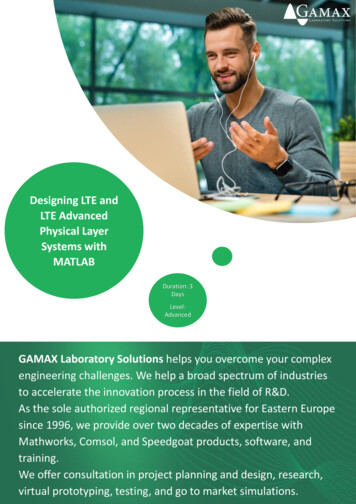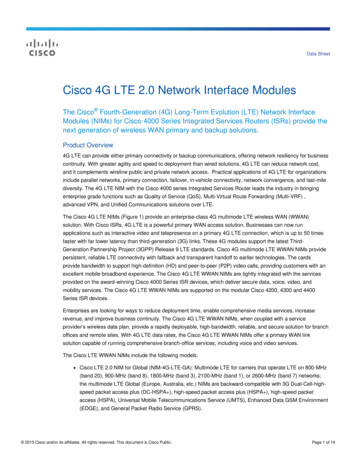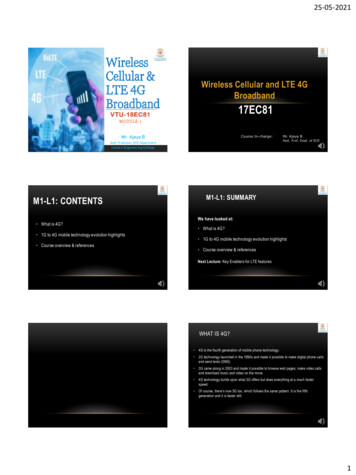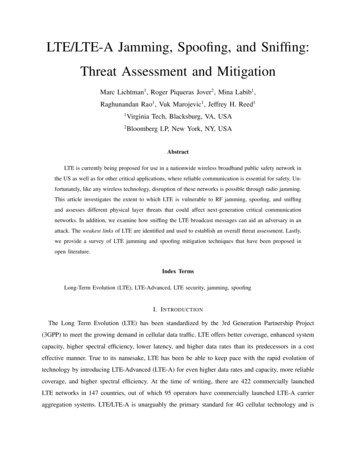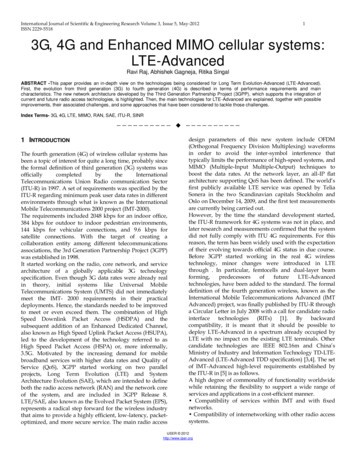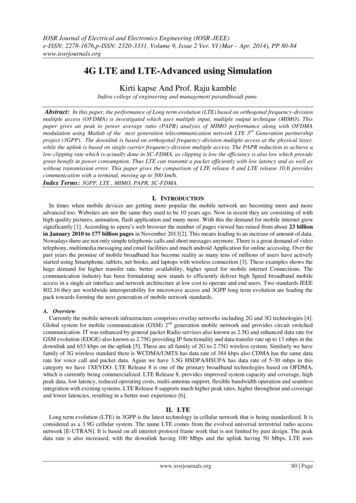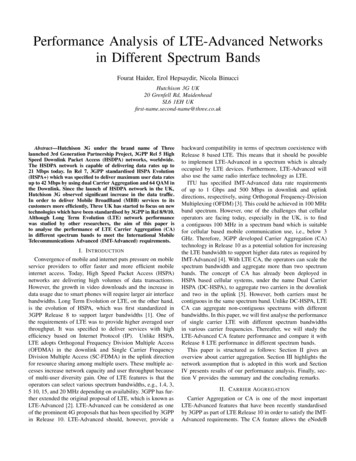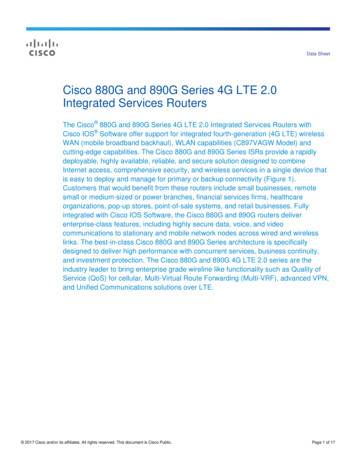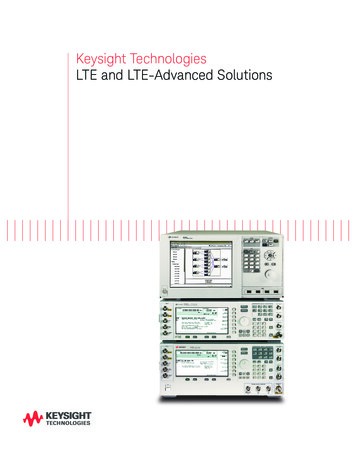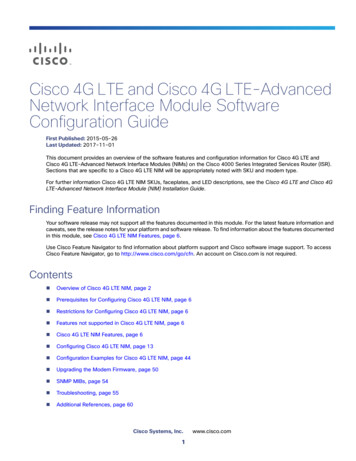
Transcription
Cisco 4G LTE and Cisco 4G LTE-AdvancedNetwork Interface Module SoftwareConfiguration GuideFirst Published: 2015-05-26Last Updated: 2017-11-01This document provides an overview of the software features and configuration information for Cisco 4G LTE andCisco 4G LTE-Advanced Network Interface Modules (NIMs) on the Cisco 4000 Series Integrated Services Router (ISR).Sections that are specific to a Cisco 4G LTE NIM will be appropriately noted with SKU and modem type.For further information Cisco 4G LTE NIM SKUs, faceplates, and LED descriptions, see the Cisco 4G LTE and Cisco 4GLTE-Advanced Network Interface Module (NIM) Installation Guide.Finding Feature InformationYour software release may not support all the features documented in this module. For the latest feature information andcaveats, see the release notes for your platform and software release. To find information about the features documentedin this module, see Cisco 4G LTE NIM Features, page 6.Use Cisco Feature Navigator to find information about platform support and Cisco software image support. To accessCisco Feature Navigator, go to http://www.cisco.com/go/cfn. An account on Cisco.com is not required.Contents Overview of Cisco 4G LTE NIM, page 2 Prerequisites for Configuring Cisco 4G LTE NIM, page 6 Restrictions for Configuring Cisco 4G LTE NIM, page 6 Features not supported in Cisco 4G LTE NIM, page 6 Cisco 4G LTE NIM Features, page 6 Configuring Cisco 4G LTE NIM, page 13 Configuration Examples for Cisco 4G LTE NIM, page 44 Upgrading the Modem Firmware, page 50 SNMP MIBs, page 54 Troubleshooting, page 55 Additional References, page 60Cisco Systems, Inc.1www.cisco.com
Cisco 4G LTE and Cisco 4G LTE-Advanced Network Interface Module Software Configuration GuideOverview of Cisco 4G LTE NIMOverview of Cisco 4G LTE NIMCisco 4G LTE NIM addresses the modular 4G LTE cellular connectivity on the Cisco 4000 Series ISRs. This is the firstwireless NIM, though it is not the first wireless module in the ISR product line. The closest modular card to Cisco 4G LTENIM is the Cisco EHWIC 4G LTE, which accepts a single LTE modem. Cisco 4G LTE NIM is feature-compatible withCisco EHWIC 4G LTE.Cisco 4G LTE NIMs support the following 4G/3G modes: 4G LTE—4G LTE mobile specification provides multi-megabit bandwidth, more efficient radio network, latencyreduction, and improved mobility. LTE solutions target new cellular networks. These networks initially support up to100 Mb/s peak rates in the downlink and up to 50 Mb/s peak rates in the uplink. The throughput of these networksis higher than the existing 3G networks 3G Evolution High-Speed Packet Access (HSPA/HSPA )—HSPA is a UMTS-based 3G network. It supportsHigh-Speed Downlink Packet Access (HSDPA) and High-Speed Uplink Packet Access (HSUPA) data for improveddownload and upload speeds. Evolution High-Speed Packet Access (HSPA ) supports Multiple Input/MultipleOutput (MIMO) antenna capability. 3G Evolution-Data Optimized (EVDO or DOrA) Mode—EVDO is a 3G telecommunications standard for the wirelesstransmission of data through radio signals, typically for broadband Internet access. DOrA refers to EVDO Rev-A.EVDO uses multiplexing techniques including Code Division Multiple Access (CDMA), as well as Time DivisionMultiple Access (TDMA), to maximize both individual users' throughput and the overall system throughput.Table 1 describes the Cisco 4G LTE NIM SKUs.Table 1Cisco 4G LTE NIM SKUsCisco 4G LTE E-GANIM-4G-LTE-GA (Spare)NIM-4G-LTE-GA (TAA Spare)Cisco LTE 2.0 4G NIM forglobal Wireless networks(Europe, Australia and soon). LTEGlobal800 MHz, 900 MHz. 1800 MHz,2100 MHz, 2600 MHz HSPA /UMTS LTE HSPA , UMTS LTE EVDO Rev-A/1xRTT LTE EVDO Rev-A/1xRTT850 MHz, 900 MHz, 1900 MHz,2100 MHzThis SKU is based on SierraWireless MC7304 modem.NIM-4G-LTE-NANIM-4G-LTE-NA (Spare)NIM-4G-LTE-NA (TAA Spare)Cisco LTE 2.0 4G NIM forwireless networks in NorthAmerica (AT& T andCanada).North America 700 MHz. 1900 MHz, AWS(AT&T and850 MHz, 900 MHz, 1900 MHzCanada)This SKU is based on SierraWireless MC7354 modem.NIM-4G-LTE-VZNIM-4G-LTE-VZ (Spare)NIM-4G-LTE-VZ (TAA Spare)Cisco LTE 2.0 4G NIM forVerizon wireless networks.NIM-4G-LTE-STNIM-4G-LTE-ST (Spare)NIM-4G-LTE-ST (TAA Spare)Cisco LTE 2.0 4G NIM forSprint wireless networks.This SKU is based on SierraWireless MC7350 modem.This SKU is based on SierraWireless MC7350 modem.2North America AWS, 700 MHz(Verizon)0, 1, 10North America PCS 1900 MHz(Sprint)0, 1, 10
Cisco 4G LTE and Cisco 4G LTE-Advanced Network Interface Module Software Configuration GuideOverview of Cisco 4G LTE NIMTable 1Cisco 4G LTE NIM SKUs (continued)Cisco 4G LTE Cisco 4G LTE NIM module(LTE 2.5) for LATAM/APACcarriers. LTE: FDDLatin America, LTE bands 1, 3, 5, 7, 8, 18, 19,Asia-Pacific21, 28, 38, 39, 40, and 41 This SKU is based on SierraWireless MC7430 modem. LTE: TDD DC-HSPA ,HSPA , HSPA,UMTSTD-SCDMABandFDD LTE 700 MHz (band 28),850 MHz (band 5 CLR), 850 MHz(bands 18 and 19 Low), 900 MHz(band 8), 1500 MHz (band 21),1800 MHz (band 3), 2100 MHz(band 1), or 2600 MHz (band 7)TDD LTE 1900 MHz (band 39),2300 MHz (band 40), 2500 MHz(band 41), or 2600 MHz (band38)NIM-LTEA-LA LTE: FDD This SKU is based on SierraWireless EM7430 modem. LTE: TDDCisco 4G LTE-AdvancedNIM module (LTE3.0) forLATAM/APAC carriers.DC-HSPA ,HSPA ,HSPA,UMTSLatin America, LTE bands 1, 3, 5, 7, 8, 18, 19,Asia-Pacific21, 28, 38, 39, 40, and 41FDD LTE 700 MHz (band 28),850 MHz (band 5 CLR), 850 MHz(bands 18 and 19 Low), 900 MHz(band 8), 1500 MHz (band 21),1800 MHz (band 3), 2100 MHz(band 1), or 2600 MHz (band 7)TDD LTE 1900 MHz (band 39),2300 MHz (band 40), 2500 MHz(band 41), or 2600 MHz (band38)Carrier aggregation bandcombinations:1 (8,18,19,21); 3 (5,7,19,28);7 (5,7,28); 19 21, 38 38,39 39,40 40, and 41 413
Cisco 4G LTE and Cisco 4G LTE-Advanced Network Interface Module Software Configuration GuideOverview of Cisco 4G LTE NIMTable 1Cisco 4G LTE NIM SKUs (continued)Cisco 4G LTE EACisco 4G LTE-AdvancedNIM module (LTE3.0) forEU/NA carriers. LTE: FDDLTE bands 1-5, 7, 12, 13, 20, 25,26, 29, 30, and 41 This SKU is based on SierraWireless EM7455 modem. EuropeanUnion, NorthAmericaLTE: TDDDC-HSPA ,HSPA ,HSPA,UMTSFDD LTE 700 MHz (band 12),700 MHz (band 29), 800 MHz(band 20), 850 MHz (band 5CLR), 850 MHz (band 26 Low),900 MHz (band 8), 1800 MHz(band 3), 1900 MHz (band 2),1900 MHz (PCS band 25), 1700MHz and 2100 MHz (band 4AWS), 2100 MHz (band 1), 2300MHz (band 30), or 2600 MHz(band 7)TDD LTE 2500 MHz (band 41)Carrier aggregation bandcombinations:1 8; 2 (2,5,12,13,29); 3 (7,20);4 (4,5,12,13,29); 7 (7,20);12 30, 5 30, and 41 41Figure 1 explains the Cisco 4G LTE NIM packet core network architecture.Figure 1Cisco 4G LTE NIM Packet Core Network ArchitectureHLR/HSSGrPCRFIP networksSGiS6aS7S4SGSNS3MMES11SAE GW(PDN GW andServing GW)S2a/b/cS10GbIu CPS12S1 UPS1 CPRNCBTSNode BeNode B2G3GLTE4ISR 4000 SeriesNon-3GPP accesswith cellular NIM364572BSC
Cisco 4G LTE and Cisco 4G LTE-Advanced Network Interface Module Software Configuration GuideOverview of Cisco 4G LTE NIMGatewaysThe Serving Gateway (SGW) routes and forwards user data packets, while also acting as the mobilityanchor for the user plane, and is the anchor for mobility between LTE and other 3GPP technologies. ThePacket Data Network (PDN) Gateway (PGW) provides connectivity from the User Equipment (UE) toexternal packet data networks by being the point of exit and entry of traffic for the UE.A UE may have simultaneous connectivity with more than one PGW for accessing multiple PDNs. ThePGW performs policy enforcement, packet filtering for each user, charging support, lawful interception,and packet screening. Another key role of the PGW is to act as the anchor for mobility between 3GPPand non-3GPP technologies such as WiMAX and 3GPP2 (CDMA 1X and EvDO).The System Architecture Evolution GW (SAE GW) is the entity that covers the PGW and SGW functionalityin the Evolved Packet Core (EPC).RNCThe Radio Network Controller (RNC) is responsible for controlling the Radio Access Network (RAN) thatare connected to it. The RNC carries out radio resource management and some of the mobilitymanagement functions and is the point where encryption is done before user data is sent to and fromthe mobile. The RNC connects to the Circuit-Switched Core Network through the Media Gateway(MGW).BTSBase Transceiver Station.BSCBase Station Controller.SGSNService GPRS Support Node.5
Cisco 4G LTE and Cisco 4G LTE-Advanced Network Interface Module Software Configuration GuidePrerequisites for Configuring Cisco 4G LTE NIMPrerequisites for Configuring Cisco 4G LTE NIM If the signal is not good at the router, use the Cisco offered antenna accessories and extension cables to place theantenna away from router in a better coverage area. You must have 4G LTE NIM network coverage where your router is physically placed. For a complete list of supportedcarriers, see the product data s-isr/datasheet-C78-734341.html. You must subscribe to a service plan with a wireless service provider and obtain a Subscriber Identity Module (SIM)card. You must install the SIM card before configuring the Cisco 4G LTE NIM or Cisco 4000 series router. For instructionson how to install the SIM card, see the Configuring a SIM for Data Calls, page 23 for more information. The standalone antenna that supports GPS capabilities must be installed for the GPS feature to work. See theCisco 4G Indoor/Outdoor Active GPS Antenna (GPS-ACT-ANTM-SMA) document for installation information.Restrictions for Configuring Cisco 4G LTE NIMFollow these restrictions and usage guideline while configuring Cisco 4G LTE NIM: Currently, cellular networks support only user initiated bearer establishment. Due to the shared nature of wireless communications, the experienced throughput varies depending on the numberof active users or congestion in a given network. Cellular networks have higher latency compared to wired networks. Latency rates depend on the technology andcarrier. Latency also depends on the signal conditions and can be higher because of network congestion. Public Land Mobile Network (PLMN) selection feature is not supported. Any restrictions that are part of the terms of service from your carrier. SMS—Only one text message up to 160 characters to one recipient at a time is supported. Larger texts areautomatically truncated to the proper size before being sent. It is strongly recommended that you configure SNMP V3 with authentication/privacy when implementing SNMP SEToperation.Features not supported in Cisco 4G LTE NIMCisco 4G LTE NIMs do not support the following Cisco IOS features: TTY support/ Line NEMO Chat scripts External DialerCisco 4G LTE NIM FeaturesCisco 4G LTE NIMs support the following major features: Global Positioning System (GPS) and National Marine Electronics Association (NMEA) streaming6
Cisco 4G LTE and Cisco 4G LTE-Advanced Network Interface Module Software Configuration GuideCisco 4G LTE NIM Features Short Message Service (SMS) 3G/4G Simple Network Management Protocol (SNMP) MIB Virtual diagnostic monitoring Mobile Equipment Personalization (MEP) lock and unlock capabilities SIM lock and unlock capabilities4G GPS and NMEAEffective with Cisco IOS Release 15.3(3)M and later releases, the Global Positioning System (GPS) feature is enabled bydefault on the supported 4G LTE ISRs and Cisco 4G LTE NIMs to provide the geographical location. Both GPS and NMEAfeatures must be configured for GPS coordinates to be obtained.Active GPS is supported on the SubMiniature version A (SMA) port. Active GPS antenna is supported only in thestandalone mode. An Active GPS antenna includes a built-in Low-Noise Amplifier that provides sufficient gain toovercome coaxial cable losses while providing the proper signal level to the GPS receiver. Active GPS antennae requirepower from the GPS receiver SMA port to operate. See the “Example: Connecting to a Server Hosting a GPS Application”section on page 7 for more information.National Marine Electronics Association (NMEA) streams GPS data either from a 4G LTE NIM through a virtual COM portand a TCP/IP Ethernet connection to any marine device (such as a Windows-based PC) that runs a commercially availableGPS-based application.The following GPS and NMEA features are supported on the Cisco 4G LTE NIMs. Objects in the CISCO-WAN-3G-MIBsupports GPS and NMEA features.Note: Assisted GPS mode is not supported. GPS standalone mode (satellite-based GPS). Cisco IOS CLI display coordinates. Virtual and physical serial ports can export NMEA-formatted GPS data. External application displays router map location. The Cisco 4G LTE NIMs only support NMEA over IP.For instructions on setting up the GPS antenna, see the Cisco 4G Indoor/Outdoor Active GPS Antenna(GPS-ACT-ANTM-SMA) document.Example: Connecting to a Server Hosting a GPS ApplicationYou can feed the NMEA data to a remote server that hosts the GPS application. The server can be connected to the routereither directly using an Ethernet cable or through a LAN or WAN network. If the application supports serial port, run aserial port emulation program to create a virtual serial port over the LAN or WAN connection.Note: Microsoft Streets & Trips is a licensed software that you can download from the Microsoft website.To connect a Cisco 4G LTE NIM through IP to a PC running Microsoft Streets & Trips, perform the following steps:1. Connect the PC to the router using an Ethernet cable.2. Ensure that the PC and router can ping.3. Launch the serial port redirector on the PC.7
Cisco 4G LTE and Cisco 4G LTE-Advanced Network Interface Module Software Configuration GuideCisco 4G LTE NIM Features4. Create a virtual serial port that connects to the NMEA port on the router.5. Launch Microsoft Streets & Trips on your PC.6. Select the GPS Menu.7. Click Start Tracking.8. If you have acquired a location fix from the show cellular gps command output on the router, the current location isplotted on the graph, and a reddish brown dotted cursor with a circle around it is seen on the map.Note: If you have not acquired a location fix, the Microsoft application times out and disconnects.Dual SIM CardDual SIM card allows SIMs to be active in either slot. Dual SIM card is supported only on NIM-LTEA-LA (EM7430) andNIM-LTEA-EA (EM74550).SIM card primary slot is selected when router boots up or when NIM reloads. The default slot is 0. If SIM card is notpresent in the primary slot, select the alternative slot if SIM card is present.controller cellular 0/x/0lte sim primary slot slot# If the active SIM card loses connectivity to the network a failover to the alternative SIM card slot occurs.Auto SIMAuto-SIM is supported in Sierra wireless firmware Ver 02.20.03.A new CLI is added in the cellular controller to enable/disable Auto-SIM.The modem in Auto-SIM mode selects the right carrier firmware after a SIM slot switch and an automatic modem reset.Auto-SIM is supported on the MC7455, MC7430, EM7430, and EM7455 modems. During bootup, if the Auto-SIMconfiguration on the modem doesn’t match to the IOS configuration, the corresponding Auto-SIM or manual mode ispushed to the modem.After an Auto-SIM configuration change, the modem is automatically reset. Once it is up, issue a modem power-cyclefor auto-sim to take effect. The default is “auto-sim” enabled.Enable Auto-SIM:router(config)#controller cellular slot router(config-controller)#lte firmware auto-sim#default is auto-sim enabledNote: After enabling auto-sim, wait for 5 minutes until the radio comes up. Once the radio is up, issue a modempower-cycle and wait for 3 minutes for the radio to come up again. Modem Power-Cycle is mandatory for auto-simconfiguration to take effect.Disable Auto-SIM:router(config)#controller cellular slot router(config-controller)#no lte firmware auto-simNote: After disabling auto-sim, wait for 5 minutes until the radio comes up. Once the radio is up, issue a modempower-cycle and wait for 3 minutes for the radio to come up again. Modem Power-Cycle is mandatory for auto-simconfiguration to take effect.If Auto-SIM is disabled and the modem is in manual mode, select a carrier with a new exec CLI:router#cellular lte firmware-activate firmware-index 8
Cisco 4G LTE and Cisco 4G LTE-Advanced Network Interface Module Software Configuration GuideCisco 4G LTE NIM FeaturesThe following CLI shows the firmware-index of the carrier in the modem:router#show cellular slot firmwareDying-GaspThe hardware/software feature is supported on only NIM-LTEA-LA (EM7430) and NIM-LTEA-EA (EM74550). Anadditional daughter card is attached to NIM; this daughter card which can provide standby power to modem for 600 ms.Dying-Gasp SMS and destination is preconfigured through the CLI. On detecting power loss to NIM, the modem istriggered to send preconfigured SMS.Triggers Router power loss Module Reload Module stop or Router crashConfiguring Dying-GaspDETAILED STEPS1.Command or ActionPurposeconfigure terminalEnters global configuration mode.ExampleRouter# configure terminal2.controller cellular Cellular-Interface-NumberEnters controller mode for an interface.ExampleRouter(config)# controller Cellular 13.lte dying-gasp sms send destination-numbersms-messageEnables dying-gasp on the NIM.Examplesms-message—Maximum number ofcharacters is 160.Router(config-controller)# lte dying-gasp sms send[destination-number] [sms-message]destination-number is destination phonenumberTo disable dying-gasp use the “no” form ofthe command. For example:no lte dying-gasp sms send[destination-number] [sms-message]4.Note: Reset the modem in order for changesto take effect.show cell Int/SubInt/Port dying-gaspExample:#show cell 0/1/0 dying-gasp Dying-Gasp Information Dying-Gasp Detach: EnabledSMS: EnabledSMS Message testing for dgDestination Number 12345678919
Cisco 4G LTE and Cisco 4G LTE-Advanced Network Interface Module Software Configuration GuideCisco 4G LTE NIM FeaturesShort Message Service (SMS) CapabilitiesCisco 4G LTE NIMs support receiving, transmitting, archiving, and deleting of SMS messages. This support includes theability to view up to 25 received texts, and archive more messages in a custom file location. SMS is supported on multiplecarriers. Cisco 4G LTE NIMs also have the capability to revert from LTE SMS to 3G and 2G SMS technology if necessary.A sending device behind a Cisco 4G LTE NIM transmits an SMS text message over the 4G cellular link through cellulartowers until it the message reaches the recipient’s router, which then notifies the recipient device, such as a cell phone.The receiving device uses the same process to return a reply to the sending device. Figure 2 describes the flow from amobile device to a sending device. For SMS transmission to work, end users must have a text-capable device, andoptionally, a text plan. If end users do not have a text plan, standard SMS rates apply to their text transmissions.Figure 2SMS NetworkCellularLocal celltowerReceiving celltowerCisco Router360566Any Text capabledeviceUser endUsing a SIM CardCisco 4G LTE NIMs needs an active SIM card provided by a service provider. The SIM cards are usually provided in anunlocked state so that it can be used without a Personal Identification Number (PIN). If the SIM is unlocked, it can beinserted into a 4G LTE NIM and used without an authorization code.The SIM can be initially locked with a PIN code (4 to 8 digits s long) defined by the service provider. Contact your serviceprovider for the PIN code.The SIM-Lock feature allows a SIM to be locked or unlocked with a PIN code so that it is used only in an authorizeddevice. Perform the SIM lock and unlock procedures using the Cisco IOS CLI through a console or Telnet/SSH to the ISR.After the SIM is locked, it cannot initiate a call unless authentication is done using the same PIN. Authentication is doneautomatically by Cisco IOS through configuration of the PIN. This mandatory configuration for automatic SIMauthentication is done using the Cisco IOS CLI as part of the router startup configuration.10
Cisco 4G LTE and Cisco 4G LTE-Advanced Network Interface Module Software Configuration GuideCisco 4G LTE NIM FeaturesAfter the Cisco IOS configuration is in place, the ISR can initiate an LTE connection. The ISR uses the configured PIN toauthenticate prior to the LTE connection. If the Cisco IOS PIN configuration is missing or if the PIN is incorrect, the SIMauthentication will fail and the connection will not be initiated.If the locked SIM is moved to a different ISR or to another device, or if the 4G LTE NIM in which the locked SIM residesis moved to a different 4G LTE NIM slot in the same ISR, the ISR configuration should be changed. The configuration isassociated with the cellular controller that is specific to an ISR 4G LTE NIM slot number. This will ensure that the SIM cardwill not be used in any unauthorized device, or, if there are multiple 4G LTE NIMs in a single ISR, that the appropriate PINis applied to each 4G LTE SIM. An authentication command (with the same PIN used to lock the SIM) must be definedon the new device or on the new cellular controller slot to successfully initiate the LTE connection.The following procedures are used to configure a SIM: Locking and Unlocking a SIM Card Using a PIN Code, page 23 Applying a Modem Profile in a SIM Configuration, page 26Caution: It is very important to use the correct PIN after it is configured. The SIM card will be blocked if the wrongPIN is entered three consecutive times on a locked SIM during authentication or when trying to unlock a locked SIM.You can unblock a blocked SIM card using the PUK code. Contact your service provider for the PUK code.Use the cellular slot lte sim unblock PUK code new PIN code command to unblock the SIM.Data Account ProvisioningOne or more modem data profiles can be created to provision a modem on a 4G LTE NIM. An active wireless accountwith a service provider with one or more (dual) SIM cards must be installed. The modem data profile is pre-configuredon the modem.The following tasks are used to verify the signal strength and service availability of the modem and to create, modify, anddelete modem data profiles: Verifying Modem Signal Strength and Service Availability, page 13 Guidelines for Creating, Modifying, or Deleting Modem Data Profiles, page 15IP Multimedia Subsystem ProfilesIP Multimedia Subsystem (IMS) profiles establish a session, and are a part of the modem configuration and are stored inthe modem's NVRAM. An IMS network is an access-independent and standard-based IP connectivity service thatenables different types of multimedia services to end users using common Internet-based protocols. See “Guidelines forCreating, Modifying, or Deleting Modem Data Profiles” section on page 15, for more information.Cisco 4G LTE NIM LEDsTable 2 describes the LED behavior in NIM-4G-LTE-LA (MC7430).Table 2Cisco 4G LTE NIM-4G-LTE-LA (MC7430) LED DescriptionLEDColorDescriptionENGreen (solid)Indicates powered on status and functioning normally.Amber (solid)Indicates module has some type of failure.OffIndicates module does not have power.11
Cisco 4G LTE and Cisco 4G LTE-Advanced Network Interface Module Software Configuration GuideCisco 4G LTE NIM FeaturesTable 2Cisco 4G LTE NIM-4G-LTE-LA (MC7430) LED Description (continued)LEDColorDescriptionWWANGreen (solid)Indicates the modem is powered, associated, and authenticatedbut not receiving or transmitting data.Green (slow blinking)Indicates the modem is powered, but not associated orauthenticated; still searching for service.Green (fast blinking)Indicates the modem is powered and is transmitting or receiving.Amber (solid)Indicates the modem is reserved for future use.OffIndicates the modem is in reset mode.Green (solid)Indicates a high RSSI (greater than –69 dBm).Blue (solid)Indicates medium RSSI (-89 to -69dBm).Amber (solid)Indicates low RSSI (-99 to -89dBm).Amber (blink)Indicates RSSI is below -100dBm.OffIndicates no service detected.Green (solid)Indicates 4G service is enabled (LTE).Blue (solid)Indicates 3G service is enabled, e.g. EDVO, HSPA .Amber (solid)Indicates 2G service is enabled, e.g. 1xRTT, EDGE.OffIndicates no service detected.Green (solid)Indicates GPS service is enabled.OffIndicates the GPS is not active or not detected.RSSISERVICEGPSTable 3 describes the LED behavior in NIM-LTEA-LA (EM7430) and NIM-LTEA-EA (EM7455).Table 3NIM-LTEA-LA (EM7430) and NIM-LTEA-EA (EM7455) LED DescriptionLEDColorDescriptionENGreen (solid)Indicates powered on status and functioning normally.Amber (solid)Indicates module has some type of failure.SIM0 and SIM1(LED)RSSIOffIndicates module does not have power.Green (solid)Indicates the modem is powered, associated, and authenticatedbut not receiving or transmitting data.Green (slow blinking, On5sec, Off 200ms)Indicates the modem is powered, but not associated orauthenticated; still searching for service.Green (fast blinking, On400ms, Off 100ms)Indicates the modem is powered and is transmitting or receiving.Green (fast blinking, On500ms, Off 500ms)Indicates the modem is in low power mode. Modem radio is Off.Green (very slow blinking, On500ms, Off 500ms, On500ms, Off 500ms, Off 30msIndicates the modem is receiving power, associated, andauthenticated on a roaming network.OffIndicates the modem is in reset mode.Green (one solid)Indicates RSSI is under –100dBm.Green (two solid)Indicates low RSSI (-99 to -89dBm).Green (three solid)Indicates medium RSSI (-89 to -69dBm).Green (four solid)Indicates high RSSI (greater than -69dBm).OffIndicates no service detected.12
Cisco 4G LTE and Cisco 4G LTE-Advanced Network Interface Module Software Configuration GuideConfiguring Cisco 4G LTE NIMTable 3NIM-LTEA-LA (EM7430) and NIM-LTEA-EA (EM7455) LED Description (continued)LEDColorDescriptionSERVICEGreen (solid)Indicates 4G service is enabled (LTE).Blue (solid)Indicates 3G service is enabled, e.g. EDVO, HSPA .Amber (solid)Indicates 2G service is enabled, e.g. 1xRTT, EDGE.OffIndicates no service detected.Green (solid)Indicates GPS service is enabled.OffIndicates the GPS is not active or not detected.GPSConfiguring Cisco 4G LTE NIMNote: For Cisco 4G LTE NIMs, the numbering for slot 0, wic 0, and port 0 is 0/1/0 for all commands. Verifying Modem Signal Strength and Service Availability, page 13 Guidelines for Creating, Modifying, or Deleting Modem Data Profiles, page 15 Multiple PDN Contexts, page 20 Configuring a SIM for Data Calls, page 23 Data Call Setup, page 27 Enabling 4G GPS and NMEA Data Streaming, page 30 Configuring 4G SMS Messaging, page 33 Configuring Modem DM Log Collection, page 34 Enabling Modem Crashdump Collection, page 36 Displaying Modem Log Error and Dump Information, page 37 Configuration Examples for Cisco 4G LTE NIM, page 38 Verifying the Cisco 4G LTE NIM Configuration, page 41Verifying Modem Signal Strength and Service AvailabilityNote: For the Cisco 4G LTE NIM, the unit argument identifies the router slot, WIC slot, and port separated by slashes(0/1/0).SUMMARY STEPS1. show cellular unit network2. show cellular unit radio3. show cellular unit profile4. show cellular unit security5. show cellular unit all13
Cisco 4G LTE and Cisco 4G LTE-Advanced Network Interface Module Software Configuration GuideConfiguring Cisco 4G LTE NIMDETAILED STEPS1.Command or ActionPurposeshow cellular unit networkDisplays information about the carrier network,cell site, and available service.ExampleRouter# show cellular 0/1/0 network2.show cellular unit radioShows the radio signal strength.ExampleNote: The RSSI should be better than –90 dBmfor steady and reliable connection.Router# show cellular 0/1/0 radio3.Shows information about the modem dataprofiles created.show cellular unit profileExampleRouter# show cellular 0/1/0 profile4.Shows the security information for the modem,such as SIM and modem lock status.show cellular unit securityExampleRouter# show cellular 0/1/0 security5.Shows consolidated information about themodem, profiles created, radio signal strength,network security, and so on.show cellular unit allExampleRouter# show cellular 0/1/0 all14
Cisco 4G LTE and Cisco 4G LTE-Advanced Network Interface Module Software Configuration GuideConfiguring Cisco 4G LTE NIMGuidelines for Creating, Modifying, or Deleting Modem Data ProfilesYou can create multiple profiles on Cisco 4G LTE NIMs. We support only 7300 based modems for the Cisco 4G LTE NIMs.The following are the default Internet profile numbers for some of the modems: EM7430 – Profile 1 EM7455 (Verizon or Sprint) - Both Profile 1 and Profile 3 EM7455 (AT&T or other SP's) – Profile 1Follow these guidelines when you configure a data profile using exec mode or config mode: In most cases, you do not have to make any profile-related changes if your modem comes with a data profile, forinstance, AT&T, Sprint and Verizon. If any profile parameter changes are required for a connection type, the changes will most likely be carried out in thedefault profiles. To configure different profile types and use them for a different connection, you can create separate profiles withdifferent parameters (for instance, APN names). Note that only one profile is active at a given time. Use the show cellular unit profile command to view the data profile. An asterisk(*) symbol is displayed againstthe data profile. Double asterisk(**) symbol is displayed against the attach profile. The data profile is used to set up a data call. If you want to use a different profile, that profile needs to be made thedefault one. Use the lte sim data-profile number command to change the default profile under controller cellular0/2/0.For information on supported modems on each SKU, see Table 1, Table 2
Cisco 4G LTE NIMs support the following 4G/3G modes: 4G LTE—4G LTE mobile specification provides multi-megabit bandwidth, more efficient radio network, . typically for broadband Internet access. DOrA refers to EVDO Rev-A. . NIM-LTEA-EA Cisco 4G LTE-Advanced NIM module (LTE3.0) for EU/NA carriers. This SKU is based on Sierra

